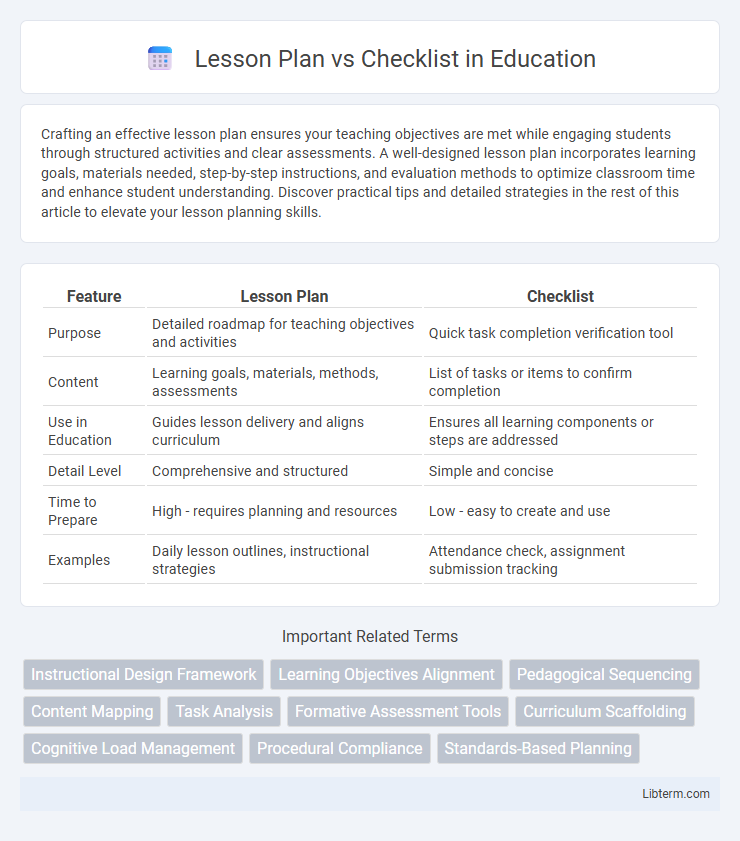Crafting an effective lesson plan ensures your teaching objectives are met while engaging students through structured activities and clear assessments. A well-designed lesson plan incorporates learning goals, materials needed, step-by-step instructions, and evaluation methods to optimize classroom time and enhance student understanding. Discover practical tips and detailed strategies in the rest of this article to elevate your lesson planning skills.
Table of Comparison
| Feature | Lesson Plan | Checklist |
|---|---|---|
| Purpose | Detailed roadmap for teaching objectives and activities | Quick task completion verification tool |
| Content | Learning goals, materials, methods, assessments | List of tasks or items to confirm completion |
| Use in Education | Guides lesson delivery and aligns curriculum | Ensures all learning components or steps are addressed |
| Detail Level | Comprehensive and structured | Simple and concise |
| Time to Prepare | High - requires planning and resources | Low - easy to create and use |
| Examples | Daily lesson outlines, instructional strategies | Attendance check, assignment submission tracking |
Introduction to Lesson Plans and Checklists
Lesson plans serve as structured guides that outline the objectives, materials, activities, and assessment methods for a specific lesson, ensuring effective teaching and learning outcomes. Checklists function as concise, actionable tools that help educators monitor progress and ensure all necessary components or tasks are completed during lesson preparation or delivery. Understanding the distinction between comprehensive lesson plans and focused checklists enables educators to streamline their instructional strategies and maintain organized classroom management.
Defining Lesson Plans: Purpose and Structure
Lesson plans serve as detailed blueprints for educators, outlining instructional objectives, materials, activities, and assessment methods tailored to specific learning outcomes. Their structured format ensures coherent delivery of content and alignment with curriculum standards, enhancing student engagement and comprehension. In contrast, checklists function as simple tools to track completed tasks without detailing pedagogical intent or lesson flow.
What is a Checklist? Key Features and Uses
A checklist is a structured list of tasks or items used to ensure all necessary steps are completed accurately and efficiently. Key features include simplicity, clear itemization, and the ability to track progress or completion status, making it an essential tool for organization and quality assurance. Common uses of checklists span various fields, from project management and healthcare to education and aviation, helping users maintain consistency and reduce errors.
Lesson Plan vs Checklist: Core Differences
Lesson plans provide a detailed roadmap for instructional delivery, outlining learning objectives, activities, assessment methods, and timelines, while checklists serve as simple tools to track task completion and ensure essential steps are followed. Lesson plans emphasize pedagogical strategies and learning outcomes, enabling educators to design coherent lessons aligned with curriculum standards. Checklists focus on operational efficiency and accountability, supporting organization rather than instructional depth.
Benefits of Using Lesson Plans
Lesson plans provide a structured framework that enhances instructional clarity and ensures coverage of essential learning objectives, promoting consistency and effectiveness in teaching. They facilitate better time management and resource allocation, allowing educators to anticipate challenges and adapt strategies accordingly. By offering a comprehensive guide, lesson plans improve student engagement and assessment accuracy compared to checklists, which primarily serve as simple task organizers without instructional depth.
Advantages of Checklists in Education
Checklists in education enhance organization by providing clear, actionable steps that streamline lesson delivery and student assessment. They promote consistency in teaching practices and help ensure all required content and skills are covered systematically. By simplifying progress tracking, checklists improve efficiency and allow educators to identify and address learning gaps promptly.
When to Use a Lesson Plan or Checklist
Use a lesson plan when detailed guidance is required to structure educational content, objectives, and activities for effective teaching. Opt for a checklist to track completion of specific tasks or requirements in projects, ensuring no steps are missed. Lesson plans are ideal for educators aiming to deliver comprehensive instruction, while checklists benefit project managers and teams focused on task execution and quality control.
Integrating Checklists with Lesson Plans
Integrating checklists with lesson plans enhances instructional organization and student accountability by clearly outlining objectives, materials, and assessment criteria within a streamlined format. Checklists ensure all critical components of the lesson plan are addressed, supporting consistent delivery and enabling teachers to track progress efficiently. Utilizing this combination promotes focused lesson execution and facilitates timely adjustments based on student performance data.
Common Mistakes to Avoid
Confusing a lesson plan with a checklist often leads to inadequate preparation, as lesson plans require detailed learning objectives, instructional strategies, and assessment methods rather than mere task completion. A common mistake is treating checklists as comprehensive guides, ignoring the need for adaptive teaching steps that respond to student needs and learning outcomes. Overlooking alignment between lesson goals and activities results in ineffective instruction and missed opportunities for student engagement.
Conclusion: Choosing the Right Tool
Selecting between a lesson plan and a checklist depends on instructional goals and organization needs; lesson plans provide detailed guidance for content delivery and learning objectives, while checklists ensure task completion and procedural consistency. Educators benefit from integrating both tools to enhance classroom management and streamline lesson execution. Understanding when to use each tool improves teaching efficiency and supports student achievement effectively.
Lesson Plan Infographic

 libterm.com
libterm.com